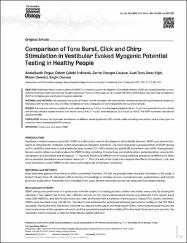| dc.contributor.author | Özgür, Abdulkadir | |
| dc.contributor.author | Erdivanlı, Özlem Çelebi | |
| dc.contributor.author | Coşkun, Zerrin Özergin | |
| dc.contributor.author | Terzi, Suat | |
| dc.contributor.author | Yiğit, Enes | |
| dc.contributor.author | Demirci, Münir | |
| dc.contributor.author | Dursun, Engin | |
| dc.date.accessioned | 2020-12-19T19:57:27Z | |
| dc.date.available | 2020-12-19T19:57:27Z | |
| dc.date.issued | 2015 | |
| dc.identifier.citation | Özgür, A., Çelebi Erdivanlı, Ö., Özergin Coşkun, Z., Terzi, S., Yiğit, E., Demirci, M., & Dursun, E. (2015). Comparison of Tone Burst, Click and Chirp Stimulation in Vestibular Evoked Myogenic Potential Testing in Healthy People. The journal of international advanced otology, 11(1), 33–35. https://doi.org/10.5152/iao.2015.927 | en_US |
| dc.identifier.issn | 1308-7649 | |
| dc.identifier.uri | https://doi.org/10.5152/iao.2015.927 | |
| dc.identifier.uri | https://hdl.handle.net/11436/2850 | |
| dc.description | WOS: 000357533000008 | en_US |
| dc.description | PubMed: 26223715 | en_US |
| dc.description.abstract | OBJECTIVE: Vestibular evoked myogenic potential (VEMP) is a clinical test used in the diagnosis of vestibular diseases. VEMP uses several stimulants to stimulate the vestibular system and measure myogenic potentials. the aim of this study was to compare the effects of tone burst, click, and chirp stimulation in VEMP on the latency and amplitude of myogenic potentials. MATERIALS and METHODS: We compared the results of 78 ears from 39 volunteers. We measured the sternocleidomastoid muscle potential of each ear following a 500-Hz tone burst, click, and chirp stimulation while in a sitting position and evaluated the latency and amplitude. RESULTS: the tone burst stimulus resulted in waves with longer latency (15.8 +/- 1.9 ms) but higher amplitude (35.9 +/- 17.1 mu V) compared with the other stimuli, and the chirp stimulus resulted in waves with shorter latency (9.9 +/- 2.4 ms) but lower amplitude (33 +/- 18.6 mu V) (p< 0.001). the VEMP asymmetry ratio did not significantly differ. CONCLUSION: Because the amplitudes and latencies of different stimuli significantly differ, further studies including more patients and stimulus types are needed to obtain standardized VEMP protocols. | en_US |
| dc.language.iso | eng | en_US |
| dc.publisher | Aves | en_US |
| dc.rights | info:eu-repo/semantics/openAccess | en_US |
| dc.subject | Chirp | en_US |
| dc.subject | Click | en_US |
| dc.subject | Tone burst | en_US |
| dc.subject | VEMP | en_US |
| dc.title | Comparison of tone burst, click and chirp stimulation in vestibular evoked myogenic potential testing in healthy people | en_US |
| dc.type | article | en_US |
| dc.contributor.department | RTEÜ, Tıp Fakültesi, Cerrahi Tıp Bilimleri Bölümü | en_US |
| dc.contributor.institutionauthor | Özgür, Abdulkadir | |
| dc.contributor.institutionauthor | Erdivanlı, Özlem Çelebi | |
| dc.contributor.institutionauthor | Coşkun, Zerrin Özergin | |
| dc.contributor.institutionauthor | Terzi, Suat | |
| dc.contributor.institutionauthor | Yiğit, Enes | |
| dc.contributor.institutionauthor | Demirci, Münir | |
| dc.contributor.institutionauthor | Dursun, Engin | |
| dc.identifier.doi | 10.5152/iao.2015.927 | |
| dc.identifier.volume | 11 | en_US |
| dc.identifier.issue | 1 | en_US |
| dc.identifier.startpage | 33 | en_US |
| dc.identifier.endpage | 35 | en_US |
| dc.ri.edit | oa | en_US |
| dc.relation.journal | Journal of International Advanced Otology | en_US |
| dc.relation.publicationcategory | Makale - Uluslararası Hakemli Dergi - Kurum Öğretim Elemanı | en_US |


















